Top Tier CPU Air Coolers Q3 2015: 9-Way Roundup Review
by E. Fylladitakis on July 6, 2015 8:00 AM ESTThe Reeven Okeanos RC-1402
Reeven is a Taiwanese newcomer in the industry. Naturally, most people reading this probably never even heard the company name before today. The company was founded just over a year ago and currently only offers CPU coolers, fans and fan controllers. Reeven sent us their most powerful CPU cooler as well, the Okeanos (RC-1402).
The box that the Reeven comes supplied in is relatively small. Nevertheless, the protection appears adequate, with polyethylene foam protecting the cooler and the bundled items packed inside a cardboard box.
The bundle is a little crudely packed and virtually kept to a minimum. Reeven supplies only the hardware necessary for the mounting of the cooler, a single dose of thermal grease, wire clips for up to three cooling fans, speed reducers for the two provided fans and a leaflet with basic installation instructions.
Reeven supplies two cooling fans alongside with the Okeanos, one 120 mm and one 140 mm fan. Both fans have black frames and genista yellow blades. These are relatively simple models, with sleeve bearings, lacking fancy blades or vibration absorbers. There is one thing of note about these two fans though: they are ridiculously powerful, with the 140 mm and the 120 mm fan rated for a maximum speed of 1700 RPM and 1800 RPM respectively.
The Okeanos is a symmetric dual tower CPU cooler, with strangely narrow towers for its class. Although the difference is very small, the fins of each tower are not precisely geometrically symmetric, with the front side having three small and the rear side one long indentations. The top fin is a 1 mm thick aluminum cover with the company logo punched on it.
The wire fan installation clips do allow moving the front fan upwards in order to gain some RAM clearance - as long as the case is wide enough, of course. Installation-wise, they are a bit of a pain, as Reeven's approach is far too crude, with the wire clips just going straight into the fan holes and clipping onto the side of the fan.
Furthermore, the frame of the 120 mm fan just barely touches the extruded sides of the fins. It is very easy for the 120 mm fan to be installed with only one side on the extruded fins, increasing noise and reducing performance.
Even though the Okeanos initially looks very simple, the bottom of the cooler makes it very interesting. The base is split between a nickel-plated copper lower part and a steel top part, providing mechanical cohesion and retention. In between these two parts, there are six heatpipes, secured with a very generous amount of solder. The two central heatpipes are 8 mm thick, while the other four heatpipes are 6 mm thick, making this the only cooler with an asymmetric heatpipe configuration in our review. The contact surface is well polished and free of imperfections, yet not machined down to a perfect mirror finish.


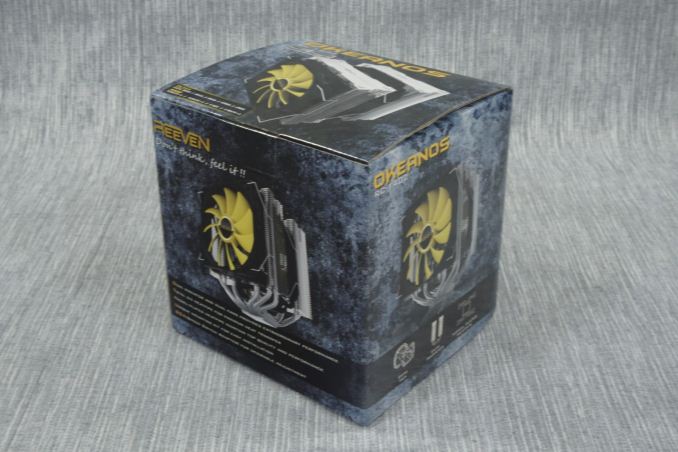
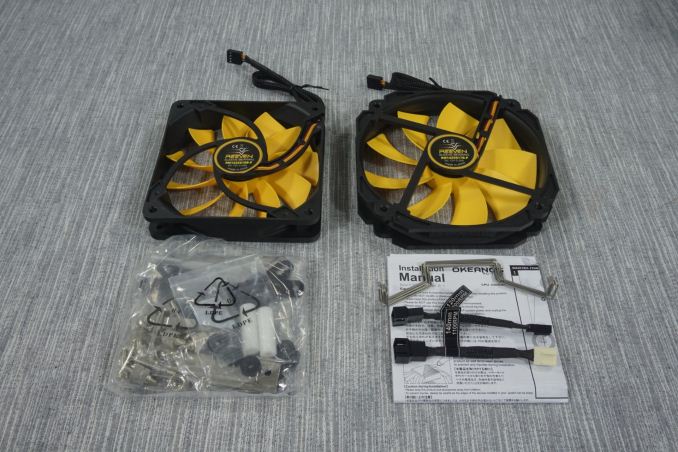
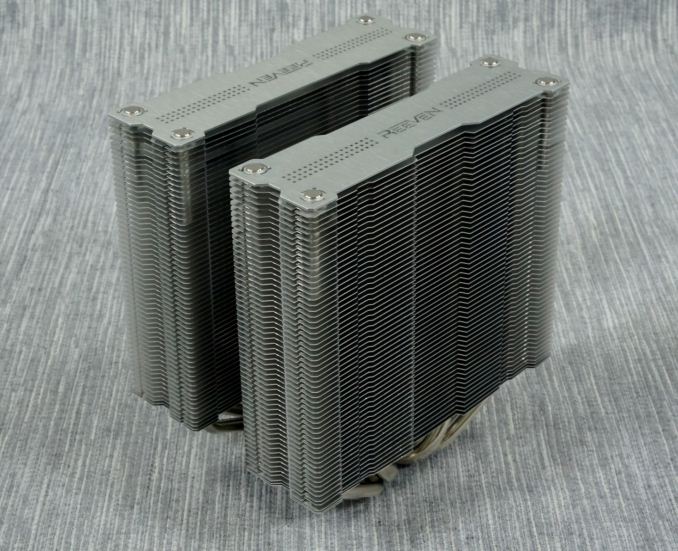
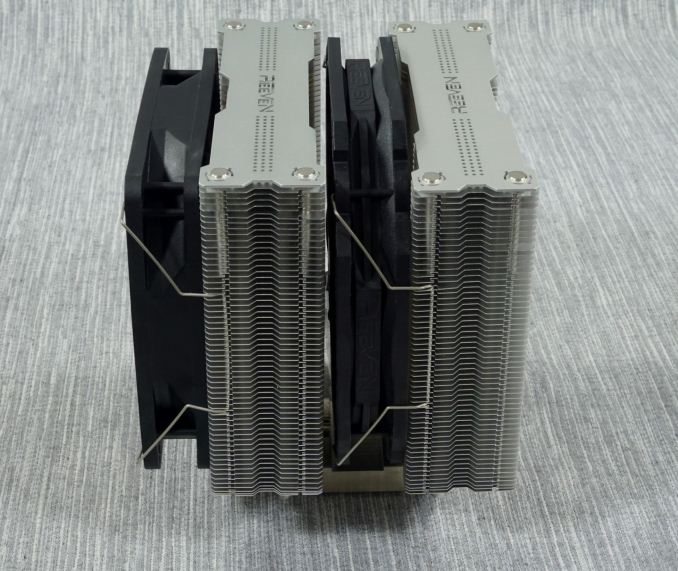
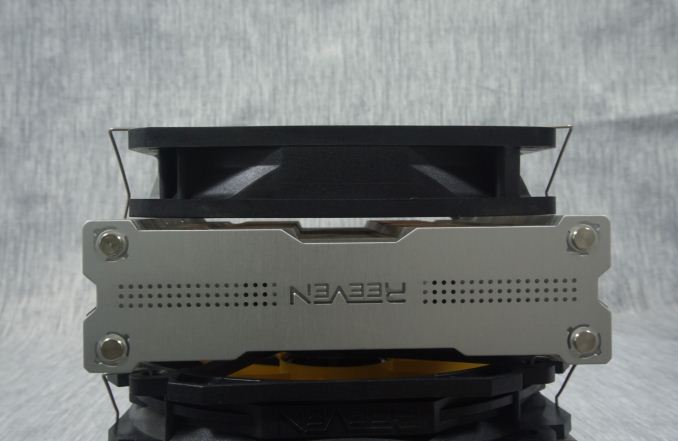
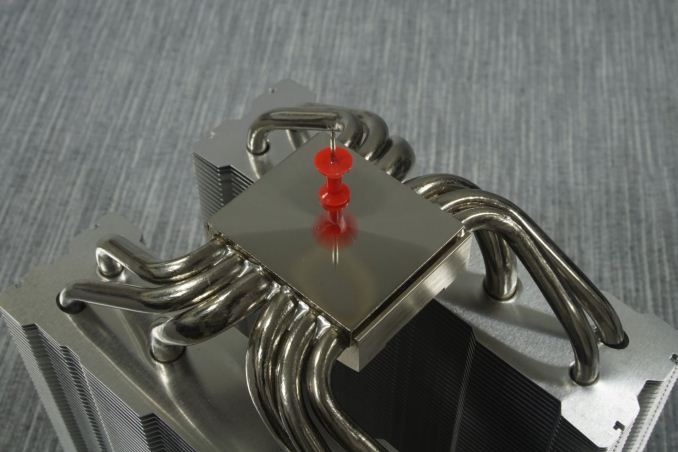








135 Comments
View All Comments
Narcissist - Tuesday, July 14, 2015 - link
I fully agree with the Oxford Guy. I've got a NoFan CR-95C cooling my non-OC i7 4790K. This in conjuction with a couple of M.2 SSD-units, a passively cooled PSU and a passively cooled graphics card makes for a 100% quiet and rather powerful computer. To be on the safe side I've added a Noctua D14 which is configured to force air across all components when the motherboard temperature gets over 50 degC. I is almost never active, though. I've run the Prime95 "Torture Test" for prolonged periods but the CPU-temp consistently stays below 70 degC. In my opinion the NoFan unit is doing a splendid job, although at a price.Sivar - Friday, February 5, 2016 - link
Listen to Oxford Guy. I've used three NoFan models and they all work amazingly well...as long as your CPU's power consumption stays under 100W. If you use a 6- or 8- core i7, or if you overclock enough to hit the 100W envelope, fanless is not for you.Note that NoFan coolers benefit only slightly when a fan is used. They are truly built as fanless coolers from the ground up.
lagittaja - Monday, July 20, 2015 - link
My HTPC has a G2120 with NH-U12P, HD5670 with Accelero S1r2, 64GB Samsung 830 + 1TB WD Black along with 80+ Plat 400W fanless PSU. Inside Lian Li A05N.Only fans being filtered intake Gentle Typhoon @~600rpm and exhaust Slip Stream ~400rpm.
Pretty overkill cooling wise. Could drop the fan speeds even further..
To answer your question, yes it can easily handle it provided there's a teeny weeny bit of airflow in the case.
Work rig has a HR-02 Macho with 800rpm Slip Stream cooling a 3770K@4.7Ghz/1.336V. Could run it fanless if I'd drop the clocks to say 4.3/1.1 or so..
Cvengr - Friday, December 25, 2015 - link
It would simply be the ratio of surface area of the fins to the surface area of the top of the CPU making contact with the heat collector. The fans merely dissipate the heat more quickly over the same area.The advantage of the fans are to transfer the heat by convection to the outer environment more quickly than allowing the heat to build up closer to other components in the system.
If designed for heat transfer, the other components are likely to have been designed assuming an ambient temperature at a particular max level, say 100-130degF. As the delta Temp between the environment and the part generating the heat will increase, so will the heat flow by conduction.
Intent is to draw the heat as far away from the components as possible.
One problem in these designs is to get the heat away from the CPU, as well as the Motherboard components, as well as other components in the case, so the interior case temperatures don't approach the environmental max design temps of those components.
A disadvantage in building by components, is that the component manufacturers are likely to only design for their particular component or one they support.
A common problem in Data Centers is how to remove all the heat from the racks and equipment within them. ANSI/TIA 942 stds go a long way to coordinate between disciplines and trades to effect proper HVAC in the server areas, but even within the racks and cabinets, too many designs limit themselves to providing a temperature set point at different areas in the room, but fail to flow adequate air over the equipment to transfer the heat away from the local electronics environments.
Computer Room Air Conditioners (CRAC) units are notorious for being installed to remove heat, but fail to provide adequate ventilation (air movement) within the computer rooms.
Since most of the CRAC units use split systems (condensate lines in 1/2" copper tubing running through the wall to a condenser outside the building), The natural trend would be to incorporate a small heat exchanger using a CPU water cooling fluid as the secondary, and the chilled water from the condensate of a HVAC system as the primary chilled water to remove the heat.
I haven't shopped the Enterprise level systems. I wonder if such systems are commodities.
sjakti - Monday, July 6, 2015 - link
Interesting article, thank you! I especially appreciate the "Quick Conclusions", that's a great table.Shadow7037932 - Monday, July 6, 2015 - link
I wish you guys had included the Hyper 212+/EVO in the review as the base comparison.zodiacfml - Monday, July 6, 2015 - link
True. It should be the default heatsink to compare with. Now that majority of Intel's CPUs become low power and efficient, these dual tower designs seem overkill except for the unlocked multiplier overclocker or fanless PCs.Achaios - Monday, July 6, 2015 - link
Obsession with CM Hyper 212 EVO "Hypertwohundredtwelvetitis" is a disease also prevalent in Overclock.net. People go berserk over the 212, almost as if they have been mass brainwashed or mass hypnotized. To my best understanding, this mass hysteria is due to the fact that cheap "enthusiasts" may save up to the hugely important sum of $9.99 if they go with the 212 compared to other coolers for the wondrous performance gain of 0.8 Celsius. In other words, the mass hysteria with the 212 is because if you go with the 212, you will save enough money in the end to buy a pack of cigarettes and a can of beer.Nagorak - Monday, July 6, 2015 - link
Well every little bit counts, and to be honest I can understand why people would not want to spend $70-$80 on a heatsink. Getting a decent heatsink for $30-$40 makes sense for a lot of people. However, if you consider wasting money buying cigarettes to be reasonable, I can understand why you wouldn't put much stock in saving a few bucks.Achaios - Monday, July 6, 2015 - link
Given how many overclockers and enthusiasts actually use the CM Hyper Evo 212 in their rigs (as eveidenced at Overclock.net) I think that Zodiacfml's suggestion of the CM hyper Evo 212 being used as a baseline cooler is a good one and I recommend the OP to take it.